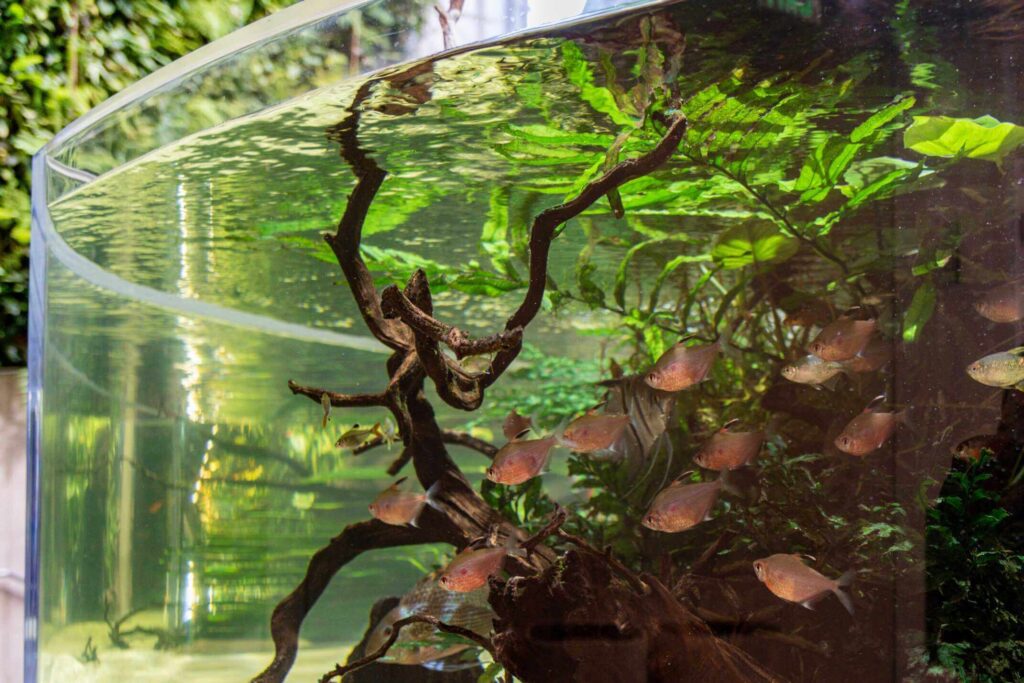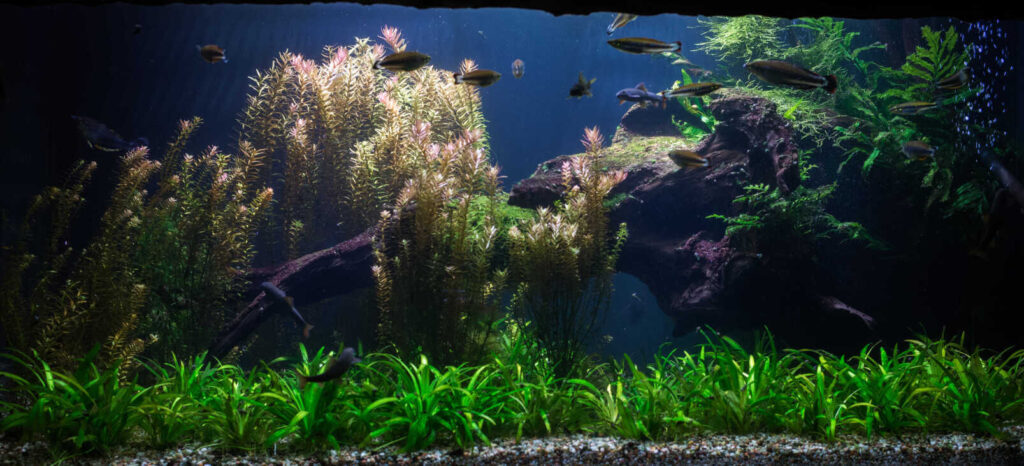Types of aquarium food
In the wild, the diet of freshwater fish is very varied. They feed on phyto- and zooplankton, organisms living in and on the surface of the water, other fish, shrimps, algae, plants and detritus. A similar variety of food should be provided to them in aquariums. Practice shows that when buying everything for an aquarium, the choice of food is often left to chance. After all, providing our fish with adequate food is crucial to keeping them in good condition. Therefore, you should get to know different types of food and consciously decide which of them will be the best in your situation.
Dry food for fish
Dry foods are by far the most popular. When visiting an aquarium shop, dozens of types, adapted to specific species of fish, catch the eye. They may contain additives that support immunity or enhance coloration. Producers divide foods into basic foods for constant use and complementary foods that diversify the daily diet. So what should characterize good-quality dry food? If we choose the staple food, it should of course provide a complete set of nutrients that are needed for the proper functioning of our fish. When choosing a specific company, it is worth considering its experience in food production and checking whether it conducts research on the impact of food on the welfare of fish. The food we choose should be adapted to the nutritional requirements of the species and be readily eaten by the fish.
The undoubted advantage of dry foods is that they are easy to store and serve. They provide a complete set of nutrients in one formula. They are also biologically safe foods. Their production takes place under controlled conditions and is subject to regular laboratory tests, therefore the probability that we will introduce hazardous substances into the aquarium with dry food is really small.
Despite the presented advantages, not every aquarium enthusiast is an advocate of feeding dry food, because it differs significantly from the natural diet of fish. And here it is difficult to disagree. The dry petals are nothing like larvae or plankton, which are a food source in rivers, ponds and lakes. It should also be borne in mind that low-quality dry food can contaminate the water and, due to poor digestibility, cause contamination of the aquarium with nitrogen and phosphorus compounds.

The undoubted advantage of dry foods is their large selection. In professional stores offering aquarium equipment, we can easily find foods intended for omnivorous fish, typically plant-based and containing only animal products. We can also adjust the food due to its method of collection. If we have fish species that eat from the surface of the water, choose food in flakes, pellets or sticks. For fish in the middle of the aquarium, foods that slowly sink, such as flakes or chips, will work great. For fish living at the bottom of the aquarium, we choose sinking food: wafers or tablets.
Dry foods also take other forms to enrich the diet. These can be tablets stuck to the glass, cubes with a long dissolution period that work well during the travel period, freeze-dried crustaceans or insects. Drying food by freeze-drying is very beneficial due to the preservation of nutrients and taste.
You can buy everything for the aquarium, including a very large selection of professional foods, without leaving your home, in the online store https://trzmiel.com.pl
Live food for fish
The undeniable advantage of live food is that it is closest to the natural diet of fish, and its movement stimulates even picky fish to eat. On the Polish aquarium market, we can easily buy: brines (artemia), water fleas (daphnia), waterworms, bloodworms, vases, eyelashes, pipes and others.
Feeding live food, although the most natural, is also associated with the greatest risk of introducing undesirable substances into the aquarium. When we buy live food, we are never sure where it comes from. Many of the species listed above live in a polluted environment and accumulate toxic substances in their bodies. Therefore, feeding fish with live food always carries the risk of poisoning with harmful substances. We can minimize this risk by running our own live food breeding. Another disadvantage of live food is its relatively poor availability in aquarium stores and the fact that it should be kept in the refrigerator. Commercially available live food pouches are usually far too large to be administered at once.
Frozen food for aquarium fish
Frozen food is a safer alternative to live food. It is pre-cleaned and rinsed, and the low temperature neutralizes unwanted microorganisms. Unlike live food, commercial frozen foods come in easily separable small portions, which is a great advantage. Every aquarist who has ever struggled with live water spilled over the refrigerator knows it for sure. Frozen foods provide almost the same amount of nutrients as live foods, but the risks associated with feeding them are much lower. The main advantage of live food over frozen food is its mobility, which encourages fish to eat it. There are many types of frozen foods on the market, including all species sold live, various types of meat, shrimp, roe and plankton. This food must be kept in the freezer and feeding must follow after it has been thawed.
Food from the fridge?
Hardly any beginner aquarium enthusiast realizes that we can also feed fish with food products that we eat ourselves.
If we decide to serve food products, we should pay attention to their origin. This is especially important for vegetables that can be contaminated with plant protection products that are harmful to fish. We can serve food products in two ways – as a variety to the diet and as its basis. Popular components of the diet of carnivorous fish in aquariums are lean meats such as: beef heart, veal, shrimp, squid and sea fish. Before serving, they should be frozen to reduce the risk of transmission of infection and shredded, for example by blending or grating. We can also serve herbivorous species with vegetables, such as zucchini or pumpkin. Leafy vegetables should be avoided because they accumulate large amounts of harmful substances. When choosing the vegetables you want to serve to fish, pay attention to their origin. It’s best to give only those that we have grown ourselves. Before serving, it is best to peel them and pour boiling water over them.
The use of food products as a complete food is also possible, but requires the knowledge needed to create special mixtures. The recipes usually include shrimps or beef heart, green peas, gelatin, eggs and vitamins, which we add during preparation or just before serving. The content of individual ingredients is adjusted to the nutritional needs of our fish. The ratio of meat to vegetable products will be different for carnivores than for omnivores. Mix the food into a smooth mass and portion it, for example, in ice cube boxes and freeze it.
Feeding the fry
Most fish do not feed their offspring. In their natural habitat, fry have access to a wide variety of foods that are not available in aquariums. Thus, it is man’s responsibility to provide adequate nourishment. The main rule to follow when feeding the fry is to choose the right food size. In aquarium shops you will find ready-made products, adapted to feeding even the smallest fish. Adult flake foods, ground to dust, also work well. Of the natural foods, protozoa and live or frozen brine shrimp larvae are most often used. Of course, the method of feeding and the type of food depends on the nutritional preferences of a given species. Food should be given several times a day, in small portions.
How to feed the fish?
First of all, they must not be overfed! Many beginner aquarists give the fish way too much food. We start with choosing the right food, then measure a small portion and give it to the fish. Food should be eaten within several seconds. If we happen to give too much, uneaten leftovers should be removed. You have to watch our fish while feeding. If one of them refuses to eat, it may be the first sign that there is something wrong with them. We should also remember to adjust the feeding time to the daily rhythm of the aquarium inhabitants. Most fish will eat during the day, while bottom-feeding fish should be fed in the evening, after the lights are turned off.
We have many methods of feeding fish in our aquariums at our disposal. Each of them has its advantages and disadvantages. My fish’s diet is a mixed diet, mostly based on ready-made frozen foods, a small amount of commercial foods (such as spirulina flakes or bottom-fish tablets), and the occasional addition of vegetables from my own plot, such as lettuce. This type of nutrition provides access to various nutrients, which translates into the health and vitality of my pets. Let us choose food consciously, let us not rely solely on what we got with the aquarium equipment, but carefully think what and how we would like to feed our fish.

